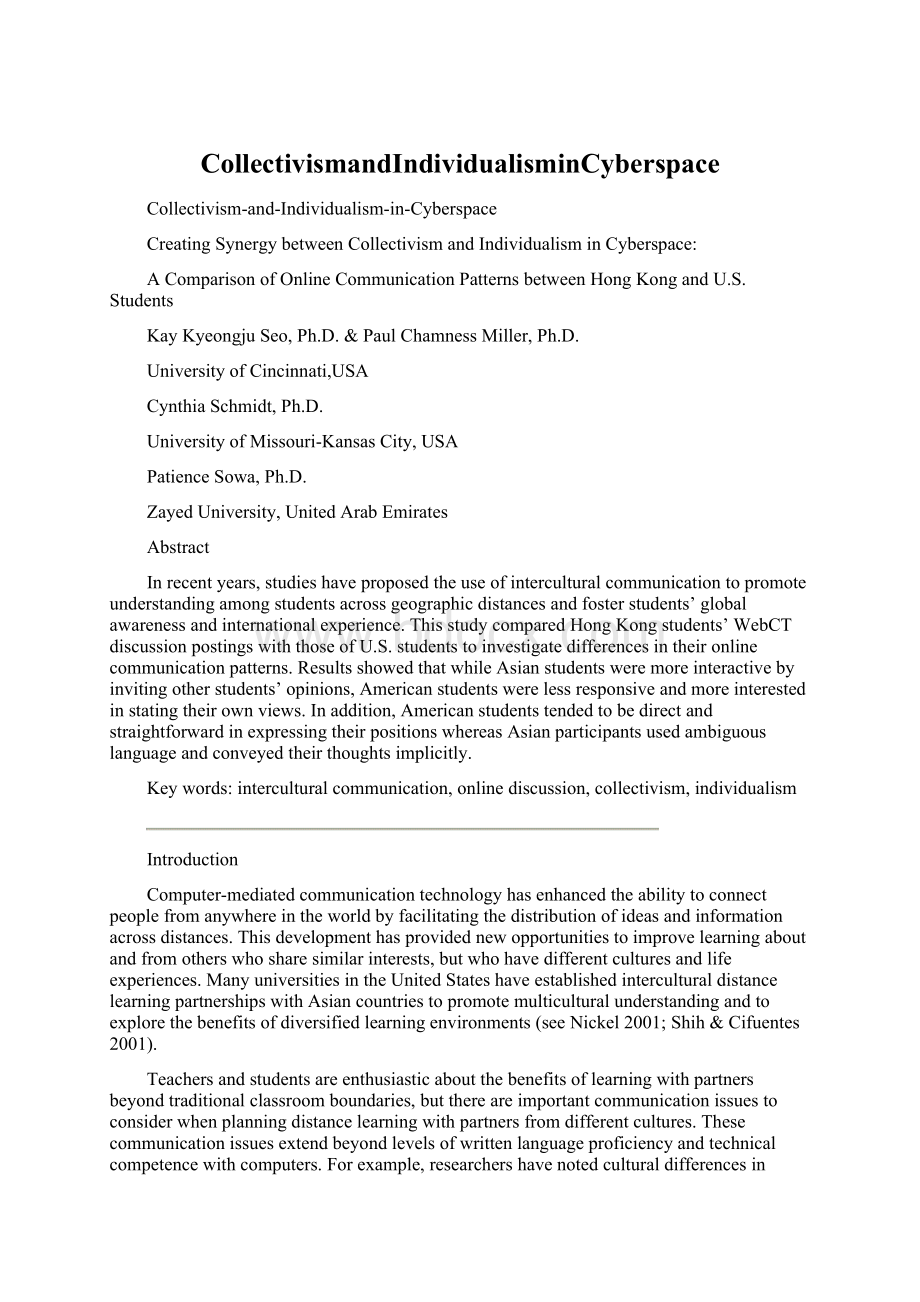CollectivismandIndividualisminCyberspaceWord格式文档下载.docx
《CollectivismandIndividualisminCyberspaceWord格式文档下载.docx》由会员分享,可在线阅读,更多相关《CollectivismandIndividualisminCyberspaceWord格式文档下载.docx(8页珍藏版)》请在冰豆网上搜索。

AComparisonofOnlineCommunicationPatternsbetweenHongKongandU.S.Students
KayKyeongjuSeo,Ph.D.&
PaulChamnessMiller,Ph.D.
UniversityofCincinnati,USA
CynthiaSchmidt,Ph.D.
UniversityofMissouri-KansasCity,USA
PatienceSowa,Ph.D.
ZayedUniversity,UnitedArabEmirates
Abstract
Inrecentyears,studieshaveproposedtheuseofinterculturalcommunicationtopromoteunderstandingamongstudentsacrossgeographicdistancesandfosterstudents’globalawarenessandinternationalexperience.ThisstudycomparedHongKongstudents’WebCTdiscussionpostingswiththoseofU.S.studentstoinvestigatedifferencesintheironlinecommunicationpatterns.ResultsshowedthatwhileAsianstudentsweremoreinteractivebyinvitingotherstudents’opinions,Americanstudentswerelessresponsiveandmoreinterestedinstatingtheirownviews.Inaddition,AmericanstudentstendedtobedirectandstraightforwardinexpressingtheirpositionswhereasAsianparticipantsusedambiguouslanguageandconveyedtheirthoughtsimplicitly.
Keywords:
interculturalcommunication,onlinediscussion,collectivism,individualism
Introduction
Computer-mediatedcommunicationtechnologyhasenhancedtheabilitytoconnectpeoplefromanywhereintheworldbyfacilitatingthedistributionofideasandinformationacrossdistances.Thisdevelopmenthasprovidednewopportunitiestoimprovelearningaboutandfromotherswhosharesimilarinterests,butwhohavedifferentculturesandlifeexperiences.ManyuniversitiesintheUnitedStateshaveestablishedinterculturaldistancelearningpartnershipswithAsiancountriestopromotemulticulturalunderstandingandtoexplorethebenefitsofdiversifiedlearningenvironments(seeNickel2001;
Shih&
Cifuentes2001).
Teachersandstudentsareenthusiasticaboutthebenefitsoflearningwithpartnersbeyondtraditionalclassroomboundaries,butthereareimportantcommunicationissuestoconsiderwhenplanningdistancelearningwithpartnersfromdifferentcultures.Thesecommunicationissuesextendbeyondlevelsofwrittenlanguageproficiencyandtechnicalcompetencewithcomputers.Forexample,researchershavenotedculturaldifferencesinpatternsofcommunicationasasignificantfactorinonlinediscussionsbetweenuniversitystudentsindifferentcountries(Liang&
McQueen2000;
Cifuentes2001).CasestudiesofAmericanmiddleschoolstudentsfromdifferentculturalbackgroundsalsoprovideinsightsintothecomplexroleofculturaldifferencesincommunicationpatternsandlearningstylesandemphasizetheimportanceofteacherplanningandscaffoldingtomaximizelearningforstudents(Cifuentes&
Murphy2000;
Freedman&
Liu1996).
Forsuccessfulpartnershipsandlearningthroughdistanceeducationtotakeplace,educatorsmustpayattentiontotheculturesoftheirstudents.Cultureisanimportantconsiderationbecause,asScollonandScollon(2000)state,culturalvaluesandnormsdetermineformsofcommunicationofdifferentgroups.Inhisstudyofculturaldiversityininstructionaldesign,Jian(2001)emphasizestheneedfordesigners,trainers,orteacherstotakeintoconsiderationtheculturesofstudentswhendesigninganddeliveringeducationaltechnology,becausethesestudentsbring"
culturallybasedrules,expectations,valuesystems,andeducationalneedstothelearningenvironment"
(Jian2001:
300).
WiththegrowinginterestinforminglearningpartnershipsbetweentheU.S.andAsiancountries,therehavebeenconsistenteffortstounderstanddifferencesincommunicationpatternsbetweenAmericanandAsiancultures.Hofstede(1986,1997)providesinsightsintomajordifferencesbetweenthetwocultures.AccordingtoHofstede’sperspectiveoncollectivismversusindividualism,theAsiancultureisacollectiveculturewherepeoplevalueharmonywithothersandemphasizehumanrelationships.Inaddition,influencedbytheteachingsofConfucius,calledConfuciandynamism,Asianpeoplepursuealong-termorientationinlife,wheretheybelieveinworkinghardtoacquireskillsandeducationinpreparationforthefuture.Ontheotherhand,intheAmericanculturepeopleseektheindependenceofeachindividual,andthesocietyislooselyconnected.Theseculturaldifferencesbetweenthetwogroupsinfluencetheircommunicationpatterns.HallandHall(1989)andGudykunstetal.(1988)notethatAsianpeople,seekingharmonyinagroup,tendtoavoiddirectexpressionoftheirownintentionsandpositions.Incontrast,Americanpeopleusemoreexplicitlanguageandmoredirectexpressionoftheirthoughts.
Theexistingliteratureonthistopicraisesthefollowingquestion:
Canthecommunicationpatternsofthesetwoculturesbeobservedinonlinediscussions?
Thel